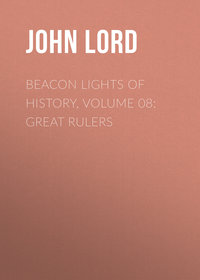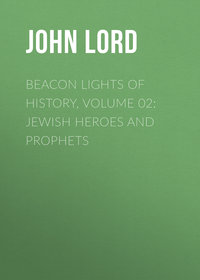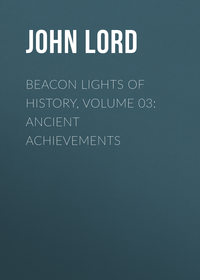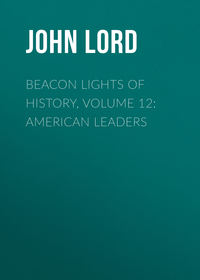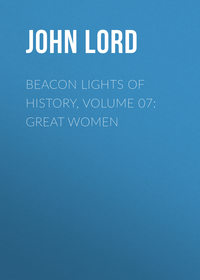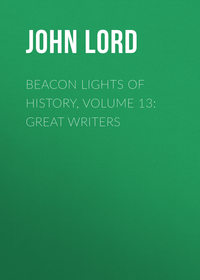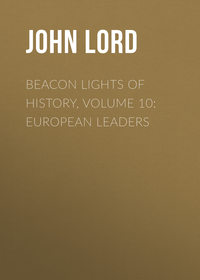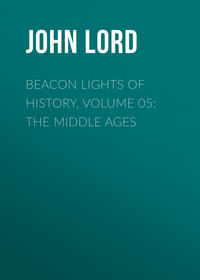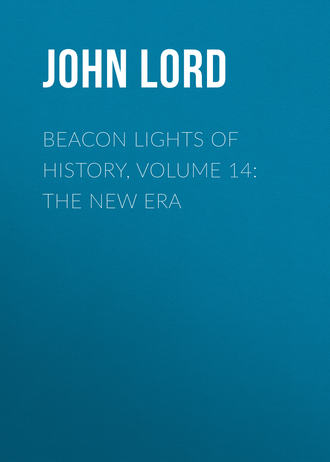 полная версия
полная версияBeacon Lights of History, Volume 14: The New Era
Before entering, somewhat in detail, into Ruskin's vast and varied labors, let us briefly outline the scope and character of the work which gave the art critic and prophet of his time his chief fame. The personal incidents in his life need not detain us at the outset, as they are not specially eventful, and may be more fully gathered from the excellent "Life" of Ruskin, by his friend and some-time secretary, W.G. Collingwood, or from the delightfully interesting reminiscences by the master himself in his autobiographic "Praeterita," published near the close of his long, arduous, and fruitful career. John Ruskin was born in London on the 8th of February, 1819. He was of Scotch ancestry, his father being a prosperous wine merchant in London, who acquired considerable wealth in trade, which the son in time inherited, and nobly used in his many private benevolences and philanthropic enterprises. The comfortable circumstances in which he was born, coupled with his father's own love of pictures and books, were helpful in giving encouragement and direction to the young student's studies and tastes. His mother, a deeply religious woman, was, moreover, influential in implanting the serious element in Ruskin's character and life, and in familiarizing him with the Bible, whose noble English, in King James' version, manifestly entered early into the youth's ardent, prophetic soul, and, as a writer, had much to do in forming his magnificent prose style. Ruskin was in early years–indeed, far on in his manhood–in delicate health, and consequently he was educated privately till he passed to Christ Church College, Oxford, where, at the age of twenty, he won the Newdigate prize for verse, and graduated in 1842. His taste for art was manifested at an early age, and after passing from the university he studied painting under J.D. Harding and Copley Fielding; but his masters, as he tells us in "Praeterita," were Rubens and Rembrandt.
At the outset of his career Ruskin, as is well known, was led to take up a defence of J.M.W. Turner (1775-1851) and the contemporary school of English landscape-painting against the foreign trammels, which had fastened themselves upon modern art, and especially to prove the superiority of modern landscape-painters over the old masters. This revolutionary opinion, though at first it was hotly contested, established the new critic's position as a writer on art, and the defence, or exposition rather, grew into the famous work called "Modern Painters" (5 vols., 1843-60). This elaborate work deals with general aesthetic principles, and, notwithstanding its occasional extravagances, alike of praise and censure, its charm is irresistible, presenting us with its brilliant and original author's ideas of beauty, to which he freshly and powerfully awakened the world, while enshrining throughout the work the most enchanting word-poems on mountain, leaf, cloud, and sea, which, it is not too much to say, will live forever in English literature. In the second volume Mr. Ruskin takes up the Italian painters, and discusses at length the merits of their respective schools; in the others, as well as in the work as a whole, we have a body of principles which should govern high art-work, as well as new ideas as to what should constitute the equipment of the painter, and that not only as regards the technique of his art, but in the effect to be produced on the onlooker in viewing the skilled work of one who, above all accomplishments, should be lovingly and intimately in contact with nature.
From the study of painting Mr. Ruskin passed for a time to that of architecture. In this department we have from his pen "The Seven Lamps of Architecture" (1849) and "The Stones of Venice" (1851-53). In these two complementary works their author sets forth as in an impressive sermon the new and admonitory lesson that architecture is the exponent of the national characteristics of a people,–the higher and nobler sort exemplifying the religious life and moral virtue in a nation, the debased variety, on the other hand, expressing the ignoble qualities of national vice and shame. The text of "The Stones" is Venice, and the design of the volumes, in the author's words, is to show that the Gothic architecture of Venice "had arisen out of, and indicated, a state of pure domestic faith and national virtue;" while its renaissance architecture "had arisen out of and indicated a state of concealed national infidelity and domestic corruption." The earlier work, "The Seven Lamps,"–the Lamp of Sacrifice, of Truth, Power, Beauty, Life, Memory, Obedience,–looks upon architecture "as the revealing medium or lamp through which flame a people's passions,–the embodiment of their polity, life, history, and religious faith in temple and palace, mart and home." Akin to these two eloquent works, in which their author thoughtfully sets forth the civic virtues and moral tone, as well as the debased characteristics, by which architecture is produced at certain eras in a people's life, is the earlier volume on "The Poetry of Architecture" (1837), which discusses the relation between architecture and its setting of landscape or other environment, illustrated by examples drawn from regions he had visited,–the English Lakeland, France, Switzerland, Spain, and northern Italy.
After these works followed lectures on drawing, perspective, decoration, and manufacture, with later theories (crotchets, some have impiously called them) on political economy, Pre-Raphaelitism, et cetera, with a flood of opinions on social, ethical, and art subjects, enriched by rare intellectual gifts and much religious fervor. Ruskin's whole writings form a body of literature unique of its kind, pervaded with great charm of literary style, and inspired by a high moral purpose. Ruskin's excursions into non-aesthetic fields, and the strange jumble of Christian communism to which, late in life, he gave vehement expression, it must be honestly admitted, have detracted much from his early fame. In everything he wrote the Ruskinian spirit comes strongly out, colored with an amiable egotism and enforced by great assurance of conviction. The moral purpose he had in view, and the charm and elevated tone of his writings, lead us to forget the wholly ideal state of society he sought to introduce, while we are won to the man by the passion of his noble enthusiasms.
Like Carlyle and Emerson, Ruskin was by his parents intended for the ministry; but for the ministry he had himself no inclination. The broadening out early of his mind and the freeing of his thought on doctrinal subjects, which took him far from the narrow evangelicalism of his youth, made the ministry of the church repugnant to him, though he was always a deeply religious man and a force ever making for righteousness. At the same time, he numbered many divines among his most cherished friends, and he frequently, and with admitted edification, was to be found in chapel and church. Meanwhile he continued busily to educate himself for whatever profession he might choose or drift into, supplemented by such fitful periods of schooling as his delicate health permitted, as well as by many jaunts with his parents to the English lakes and other parts of the kingdom, and by frequent tours on the Continent, especially in Italy and Switzerland. Before he arrived at his teens, young Ruskin had composed much, both in prose and verse, and he early manifested an aptitude for drawing, as well as a decided taste for art, which, it is said, was in some measure incited by the gift, from a partner of his father, of a copy of the poet Rogers' "Italy," with engravings by Turner. Nor, early in manhood, did he escape a youth's fond dream of love, for as a worshipper of beauty, and an enthusiast of the "Wizard of the North," we find him drawn tenderly to a daughter of Lockhart, editor of the "Quarterly Review," a grandchild of his famous countryman, Sir Walter Scott. The affair, however, though encouraged by his parents, who longed to see their son settled in life, came to nought, chiefly owing to the young lover's weak physical frame and uncertain health. Later on, unhappily, he was caught in the toils of another Scottish lass, for whom, it is related, he had written "The King of the Golden River" (1841), and whose rare beauty had readily attracted him. With her, in 1848, he made an ill-assorted marriage, only to find, some years afterwards, his heart riven and a bitter ingredient dropped into his life's chalice by a fatal defection on the wife's part, she having become enamoured of the then rising young painter, Millais, whom Ruskin had trustingly invited to his house to paint her portrait. The sequel of the affair is a pitiful one, which Ruskin ever afterward hid deep in his heart, though at the time, finding that the woman was unable to live at the intellectual and spiritual altitude of her loyal husband, the latter, with a magnanimity beyond parallel, pardoned both Millais and the erring one, consented to a divorce, and actually stood by her at the altar as the faithless one took upon herself new vows unto a new husband. The estrangement and loss of a wife gave Ruskin afresh to Art,–his true and fondly cherished bride.
At this period, as we know, English painting was at a low ebb, mediocre and conventional, though with a show of artificial brilliance. Ruskin, with his scorn of the artificial and scholastic, threw himself into the work of overturning the established, complacent school of the time, and with splendid enthusiasm and an unfailing belief in himself and his ideas he undertook to reform what had been, and to raise current conceptions of art to a more exalted and lofty plane. We have seen what he had already achieved in his first dashing period of literary activity, in the production of the early volumes of "Modern Painters," and in his "Seven Lamps" and "Stones of Venice." While he was at work on the concluding volumes of the first and last of these great books there arose in England the somewhat fantastic movement in art, launched by the Pre-Raphaelite Brotherhood, which included such Ruskinites and other devotees of early Christian and mediaeval painting as Rossetti, Millais, Morris, Burne-Jones, and Holman Hunt. Towards this new school of symbolists and affectationists Ruskin was not at first drawn, since it seemed to him unduly idealistic, if not mystic, and smacked not a little, as he thought, of popery. Later, however, he saw good in it, as a breaking away from academic trammels; while he recognized the earnest enthusiasm of the little band of artists and artist-poets, as well as their technical dexterity and brilliance. With ready decision as well as with his accustomed zeal for art, Ruskin ended by defending and applauding the new innovators, particularly as their chief motive was the one the master had always strenuously pled for,–adherence to the simplicity of nature. Their scrupulous attention to detail, characteristic of the Pre-Raphaelites, later on bore good results, even after the Brotherhood fell apart, especially in William Morris's application of their art-principles to household decoration and furnishings. But for the time the movement was loudly mocked and decried, and perhaps all the more because of Ruskin's espousal of the fervid band, his letters of defence in the London "Times," and his discussion in his booklet on "Pre-Raphaelitism." Heedless of the outcry, Ruskin pursued his own self-confident course, and by the year 1860 he had completed his "Modern Painters," and, in spite of objurgation and detraction, had won a great name for himself as a critic and expounder, while expanding himself over almost the whole world of art.
We have said that Pre-Raphaelitism, as a movement in art, was contemporaneously jeered at; while to-day, among superficial or inappreciative students of the period, seriously to mention it or any of its cultured brotherhood is to provoke a smile. Nevertheless, there was not a little high merit in the movement, which Ruskin was keen-eyed and friendly enough to recognize, while much that is worthy afterwards came out of it in the later work of the more notable of its members as well as in that of their unenrolled associates and the admirers of the Pre-Raphaelite method. What the movement owed to Ruskin is now frankly conceded, in the lesson the brotherhood took to heart from his counsellings,–to divest art of conventionality, and to work with scrupulous fidelity and sincerity of purpose. Nor was contemporary art alone the gainer by the movement; it also had its influence on poetry, though this has been obscured–so far as any beneficial influence can be traced at all–by the tendency manifested in some of the more amorous poetic swains of the period, who professed to derive their inspiration from the Brotherhood, to identify themselves with what has been styled the "Fleshly School" of verse. Of the latter number, Swinburne, in his early "Poems and Ballads," was perhaps the greatest sinner, though atoned for in part by the lyrical art and ardor of his verse, and much more by the higher qualities and scholarly characteristics of his later dramatic Work. Nor is Dante Rossetti himself, in some of his poems, free from the same taint, despite the fact of his interesting individuality as the chief inspirer and laborer among the Brotherhood. Yet the movement owed much to both his brush and his pen of other and nobler, because reverential, work, as those will admit who know "The Blessed Damozel," "Sister Helen," and his fine collection of sonnets, "The House of Life," as well as his famous paintings, "The Girlhood of Mary Virgin," and his Annunciation picture, "Ecce Ancilla Domini." Of the product of other Pre-Raphaelites of note,–such as Ford Madox Brown, Millais, Morris, Woolner the sculptor, Coventry Patmore, and Holman Hunt,–much that is commendable as well as finely imaginative came from their hands, and justified Ruskin in his gallant advocacy of the movement, its founders, and their work.
By this time, of which we have been writing, Ruskin had reached the early meridian of his powers, and, as we have hinted, had wrested from the unwilling many a juster recognition of his amazing industry and genius. To his fond and indulgent parents this was a great source of pride and satisfaction, and the practical evidence of it was the throng of visitors to the family seats of Herne Hill and Denmark Hill, in the then London suburbs, where Ruskin long had his home, and by the attentions and honor paid to their son by universities, academies, and public bodies, as well as by many eminent personages and the intellectual élite of the nation. Among those with whom the young celebrity was then ultimate and reckoned among his admiring correspondents were, besides Turner (who died in 1851) and the chief artists of the time, the Carlyles and the Brownings, Mary Russell Mitford, Charlotte Bronté, Harriet Beecher Stowe, Monckton Milnes (Lord Houghton), Charles Eliot Norton, Lady Trevelyan (Macaulay's sister), Whewell, Maurice, Kingsley, Dr. John Brown (author of "Rab and his Friends"), Tennyson, and Dean Milman. To these might be added many notable foreigners whom he either met with in his continental travels or who were attracted to him by a lively interest in his writings. In his home, thanks to a wealthy and indulgent father, he was surrounded with every comfort, short of luxury, if we except under the latter the large sums expended on the purchase of "Turners" and many famous foreign pictures, and a vast and increasing collection of favorite books and other treasures and curios.
Of the author's home-life we get many delightful reminiscences in "Praeterita," with entertaining talks of his childhood days, his youthful companions, his toys and animate pets, his early playful adventures in authorship, and other garrulities with which, late in life when the work, as it remains, was incompletely put together, he beguiled the weariness and feebleness of old age. But we are anticipating, for we are writing of Ruskin when his hand was yet on the plough, and the plough was still in the furrow, and half a long life's arduous work was yet before him. At this era, no brain could well have been more active or fuller of philanthropies than his, for we approach the second period of his life's grand activities,–the era of a new departure in the interests that occupied him and the herculean tasks he set himself to do.
Before recording some of the achievements of this time and glancing at the inciting causes of the transition which marks the era we have now reached, let us note the demands made upon Mr. Ruskin's thought and labor by universities and public institutions, whose audiences desired to have him appear before them in person and address them upon topics in which he and they were interested. These appearances on the lecture platform were now numerous, since many throughout the kingdom were eager to see and know the man whose art criticisms, principles that govern the beautiful, and stimulating thought on all subjects, had made so deep an impression on the reflecting minds of the age. His earliest appearance on the rostrum was at Edinburgh, where he delivered four lectures before the Philosophical Institution, chiefly on landscape-painters and on Christian art, with a plea for the use of Gothic in domestic architecture. Subsequent appearances were at Manchester, where he spoke on the Political Economy of Art and the relation of art to manufactures; at the South Kensington Museum, London, which had just been opened; and later at Oxford, where further on in his career he became Slade Professor of Art in his own University. From the accounts of these public lectures we get opinions as to the personal appearance of Ruskin at the period which add to our knowledge of him from paintings, drawings, and photographs, though not a few of these accounts vary from those given us in books, chiefly sketched by his lady friends and correspondents. The more trusty of the contemporary pictures speak of him as having "light, sand-colored hair; his face more red than pale; the mouth well cut, with a good deal of decision in its curve, though somewhat wanting in sustained dignity and strength; an aquiline nose; his forehead by no means broad or massive, but the brows full and well bound together; the eye [says the observer from whom we are quoting] we could not see, in consequence of the shadows that fell upon his [Ruskin's] countenance from the lights overhead, but we are sure that the poetry and passion we looked for almost in vain in other features must be concentrated here." Miss Mitford speaks of him at this time as "eloquent and distinguished-looking, fair and slender, with a gentle playfulness, and a sort of pretty waywardness that was quite charming." Another, a visitor at his London home, characterizes him as "emotional and nervous, with a soft, genial eye, a mouth thin and severe, and a voice that, though rich and sweet, yet had a tendency to sink into a plaintive and hopeless tone." Later on in years we have this verbal portrait from a disciple of the great art-teacher, occurring in an inaugural address delivered before the Ruskin Society of Glasgow: "That spare, stooping figure, the rough-hewn, kindly face, with its mobile, sensitive mouth, and clear deep eyes, so sweet and honest in repose, so keen and earnest and eloquent in debate!"
When the fifth and last volume of "Modern Painters" was finally off his hands, Mr. Ruskin not only engaged, as we have seen, in occasional lecturing, but began (1861) to add a prolific series of brochures--many of them with quaint but significant titles–to his already stupendous mass of writing. Their subjects were not alone aesthetics, but now treated of ethical, social, and political questions, the prophetic declarations and earnest appeals of a man of wide and varied culture, deep thought, and large experience. The attempted alliance of political economy with art was a novel undertaking in that sixth lustrum of the past century, even by a man of Mr. Ruskin's eminence and fame in the world of letters. But Mr. Ruskin was a bold and earnest man, as well as a genius; and he had too much to tell his heedless, laissez-faire age to keep silent on themes, remote as they were from those he had hitherto taught, and of which he desired to deliver his soul, whatever ridicule it might provoke and however adverse the criticism levelled against him. His humanity and moral sense were outraged by the manner in which the mass of his countrymen lived, and trenchant was his castigation of this and eager as well as righteous his desire to amend their condition and elevate and inspire their minds. As an economist, it is true, there was not a little that was false as well as eccentric in what he preached; moreover, much of his counsel was directly socialistic in its trend, repugnant in large degree to his English readers and hearers; but all this was atoned for by the honesty and philanthropy of his motives, by his phenomenal fervor and eloquence, and by the literary beauty and charm of every page he wrote. Nevertheless, as in Carlyle–for in these depreciations the style of the seer of Chelsea was deeply upon him–the note of calamity and the wail of despair are too much in evidence in Ruskin's writings at this period, while, like Carlyle also, he was equally precipitate and impulsive in his attacks on things as they were. Yet in the economic condition just then of England, and in the circumstances environing the labor world, there was, possibly, justification for the rebukes and objurgations of onlookers of the type of both of these men, and very humanitarian as well as practically helpful were Ruskin's counsel and aid to labor and to all who sought to raise and expand their outlook and better their condition in life. Towards politics Ruskin was never drawn, but had he been more prosaic and less given to anathematizing, most valuable would have been his aid in legislation at this era of political and moral reform. But if political science, or science in any other of its branches or departments, did not come within his purview, great was the revolution he wrought in the working-man's surroundings, and immense the illumination he shed upon industry and on the spirit in which the laborer should think and work.
Referring to Ruskin at this period of his career, and to his influence as a social and moral exhorter, Frederic Harrison, from whom we have already quoted, has an admirable passage on "Ruskin as Prophet,"2 which, as it is presumably too little known, we take pleasure in embodying in these pages.
"The influence of Ruskin," says Mr. Harrison, "has been part of the great romantic, historical, catholic, and poetic revival of which Scott, Carlyle, Coleridge, Freeman, Newman, and Tennyson in our own country have been leading spirits within the last two generations in England. There is no need to compare him with any one of these as a source of original intellectual force. He owns Scott and Carlyle as his masters, and he might vehemently repudiate certain of the others altogether. His work has been to put this romantic, historical, and genuine sympathy inspired by Scott, Wordsworth, and Carlyle into a new understanding of the arts of form. The philosophic impulse assuredly was not his own. It is a compound of Scott, Carlyle, Dante, and the Bible. The compound is strange, for it makes him talk sometimes like a Puritan father, and sometimes like a Cistercian monk. At times he talks as Flora MacIvor talked to young Waverley; at other times like Thomas Carlyle inditing a Latter-day Pamphlet. But to transfuse into this modern generation of Englishmen this romantic, catholic, historical, and social sympathy as applied to the arts of form, needed gifts that neither Scott, nor Carlyle, nor Newman, nor Tennyson possessed–the eye, if not the hand, of a consummate landscape painter, a torrent of ready eloquence on every imaginable topic, a fierce and desperate courage that feared neither man nor devil, neither failure nor ridicule, and above all things an exquisite tenderness that is akin to St. Francis or St. Vincent de Paul....
"Here is a man who, laboring for fifty years, has scattered broadcast a thousand fine ideas to all who practise the arts, and all who care for art. He has roused in the cultured world an interest in things of art such as a legion of painters and ten royal academies could never have done. He has poured out a torrent of words, some right, some wrong, but such as have raised the level of art into a new world, which have adorned English literature for centuries, and have inspired the English race for generations; he has cast his bread upon the waste and muddy waters with a lavish hand, and has not waited to find it again, though it has been the seed of abundant harvest to others."




